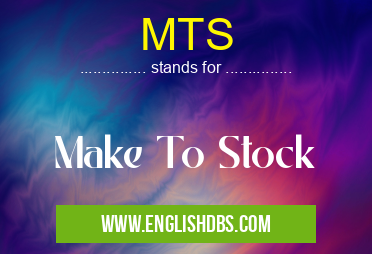What does MTS mean in US GOVERNMENT
MTS (Make To Stock) is a manufacturing strategy where finished goods are produced and stored in anticipation of future customer demand. Unlike Make to Order (MTO) where production begins only after receiving a customer order, MTS involves producing inventory in advance based on forecasted demand. This strategy is commonly employed in industries with relatively stable and predictable demand patterns.

MTS meaning in US Government in Governmental
MTS mostly used in an acronym US Government in Category Governmental that means Make To Stock
Shorthand: MTS,
Full Form: Make To Stock
For more information of "Make To Stock", see the section below.
Key Characteristics of MTS
- Focus on mass production to meet anticipated demand.
- Inventory is held in finished goods warehouses.
- Production is continuous and not tied to specific customer orders.
- Lead time is shorter compared to MTO.
Advantages of MTS
- Reduced production time: By producing in bulk, MTS streamlines production processes and reduces lead times.
- Lower production costs: Mass production allows for economies of scale, resulting in lower unit costs.
- Improved customer service: MTS ensures ready availability of finished goods, enhancing customer satisfaction and reducing order fulfillment time.
- Risk mitigation: Inventory buffers protect against unexpected demand fluctuations or supply chain disruptions.
Disadvantages of MTS
- Inventory holding costs: Maintaining finished goods inventory incurs storage, insurance, and obsolescence costs.
- Product obsolescence: MTS can lead to inventory becoming obsolete due to changes in demand or technological advancements.
- Less flexibility: MTS is less responsive to sudden changes in demand, making it challenging to adjust production quickly.
- Increased waste: Overproduction can result in excess inventory and potential waste if demand forecasts prove inaccurate.
Essential Questions and Answers on Make To Stock in "GOVERNMENTAL»USGOV"
What is Make To Stock (MTS)?
Make To Stock (MTS) is a production strategy where items are produced in advance and stored in inventory to meet anticipated customer demand. This approach is typically used for products with stable or predictable demand and a relatively long shelf life.
What are the key characteristics of MTS?
MTS is characterized by:
- Production based on forecasted demand
- Products are finished and kept in inventory before customer orders are received
- Higher inventory levels compared to other production strategies
- Focus on meeting average demand rather than specific customer orders
What are the advantages of MTS?
The advantages of MTS include:
- Lower production costs due to economies of scale
- Reduced lead times for customers
- Improved customer satisfaction by ensuring product availability
- Smoother production scheduling
What are the disadvantages of MTS?
The disadvantages of MTS include:
- Higher inventory holding costs
- Potential for obsolete inventory due to changes in demand
- Lower flexibility in meeting specific customer requirements
When is MTS most appropriate?
MTS is most appropriate for products with the following characteristics:
- Stable or predictable demand
- Long shelf life
- High production volume
- Low customization
How is MTS different from Make To Order (MTO)?
MTS differs from Make To Order (MTO) in that:
- MTS produces items based on forecast demand, while MTO produces items based on actual customer orders.
- MTS aims to maintain inventory to meet average demand, while MTO produces specific quantities to fulfill specific customer requirements.
Final Words: MTS is a manufacturing strategy suitable for businesses with predictable demand patterns seeking to reduce lead times and improve customer service. However, it requires careful demand forecasting and inventory management to avoid the challenges associated with holding finished goods inventory.
MTS also stands for: |
|
| All stands for MTS |
